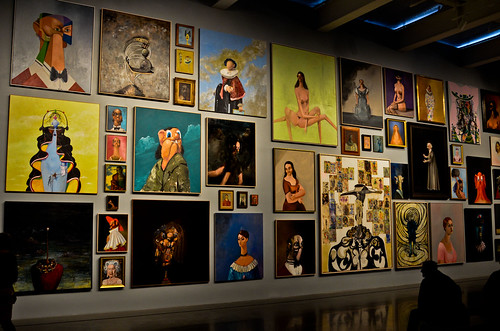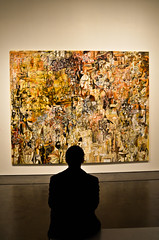 Phoenix Eisenberg A pair of retrospectives at The New Museum – one from sculptor and video artist Lynda Benglis, the other by painter George Condo – create a dialogue about the schism between body and mind.
Phoenix Eisenberg A pair of retrospectives at The New Museum – one from sculptor and video artist Lynda Benglis, the other by painter George Condo – create a dialogue about the schism between body and mind.Currently at The New Museum on The Bowery, retrospectives from sculptor and video artist Lynda Benglis and painter George Condo explore what it is to be human.
Known for challenging conventional gender roles, many of Ms. Benglis’s sculptures explore sexuality and the complicated politics of the body. Yet, whereas Ms. Benglis focuses on the corporeal, Mr. Condo operates in the realm of the abstract, with portraits that delve into the inner psyches of his subjects. Housed a floor apart from each other, the the works of these two equally provocative artists create a dialogue where soul meets body.
With sculptures steeped in vibrant color and eroticism, the bulk of Lynda Benglis’s displayed work from the past 40 years centers on the body.
The most striking example of this is 1971’s “Phantom.” Made from phosphorus-pigmented polyurethane or poured latex, the five sculptures glow green, illuminated by dramatic black light, as they pour forth from the wall like rushing lava stunted in mid-flow. More provoking, perhaps, is a lesser-known piece by the artist, “Smile” (1974). Cast in pewter a two-headed erect phallus is curved into an upward U-bend like a disembodied smile. Ms. Benglis manipulates the phallus literally as well as symbolically, undermining the sign of masculine power by bending it like balloon animal and inviting visual comparisons to sex toys. This strategy reinterprets the phallus as an object made for the purpose of female gratification.
This shift in the power dynamic toward the feminine is emphasized as, lit from above, “Smile” projects a triangular vulva-shaped shadow on the wall beneath it. Whether purposeful or coincidence, an image of the female vagina is literally created by a traditional symbol of masculinity. With her piece Ms. Benglis manages to make a visceral connection to sex and the body, while at the same time, mapping an ideology upon it.
Like Ms. Benglis, George Condo’s paintings distort and manipulate the physical form, but in an effort to reveal the inner psychology of his subjects.
In the fourth floor gallery more than 44 of Mr. Condo’s paintings from as early as 1982 hang over the expanse of one wall, like a demented collage of stately art from a funhouse. His paintings include elements of the grotesque and absurd, depicting cartoonish figures with taffy-pulled necks, dummy-like movable jaws and multiple mouths that spawn rows of jagged teeth.
This disproportionate portraiture can be seen most famously in “The Insane Queen.” The likeness of Queen Elizabeth II is instantly recognizable, her expression austere, her bluish white hair curled into place, but with one glaring discrepancy. Perched in her right eye socket is an electric-blue bulging eyeball that distorts the whole image, changing her regal demeanor to one of menace.
This feeling of mental unrest is amplified in the room Mr. Condo has titled “Manic Society.” Surrounded by four paintings, “Screaming Priest,” “Uncle Joe,” “Couple on Blue Striped Chair” and “The Return of Client No. 9,” wide-eyed figures leer at you from all sides, their mouths agape and teeth bared like hungry wolves.
Particularly nightmarish is “Couple on Blue Striped Chair,” which depicts a man and woman engaged in intercourse, their heads turned to the viewer, howling. The direct eye contact both viciously reprimands our intrusion into the intimacy of coitus, while at the same time invites it, as you can not help but stare into the faces of deranged ecstasy.
Where Ms. Benglis concentrates on the physicality of sex, Mr. Condo provides a commentary on its animalistic, unrestrained nature.
Viewed in repertory, the work from these two artists illuminates a schism between body and mind, portraying very different facets of the human beast.
The Lynda Benglis exhibit is on display until June 19 and “George Condo: Mental States” can be seen until May 8 at The New Museum, 235 Bowery.
Created with Admarket’s flickrSLiDR.




